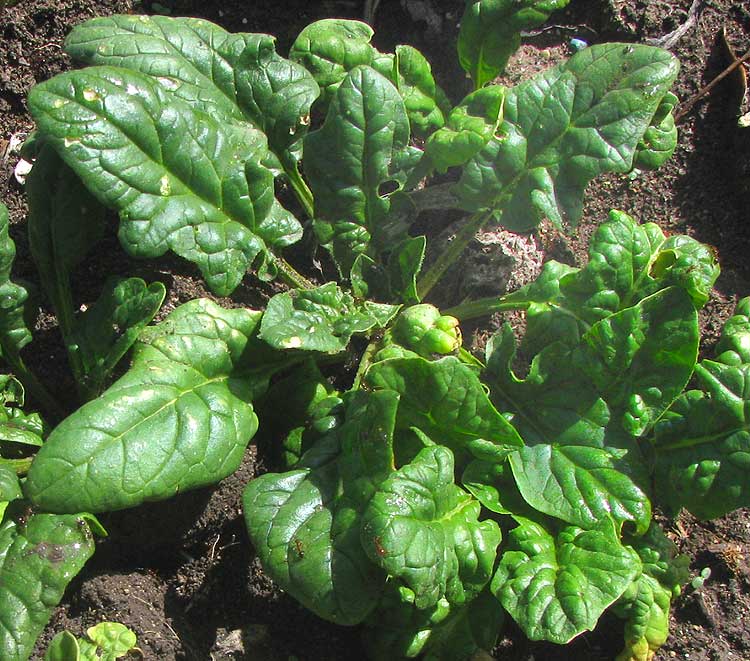Excerpts from Jim Conrad's
Naturalist Newsletter

from the January 27, 2013 Newsletter issued from the valley of the Dry Frio River in northern Uvalde County, southwestern Texas, on the southern border of the Edwards Plateau; elevation ~1750m (~5750 ft); N29.62°, W99.86°; USA
SPINACH
The wooden sides of my raised garden beds are high enough to stretch plastic across them, thus converting the beds into coldframes. Consequently, despite our having had a couple of nights recently when the temperature dropped to 24°F (-4°C), currently I have pretty crops of coldframe-grown lettuce, Chinese cabbage, Japanese radishes, mustard greens, carrots, cilantro and spinach.
On the day back in November when I discovered hoards of leafcutter ants branching out from the turnips into my other crops, I dug up what was left of the lettuce and spinach, and transplanted them into the raised beds, so that's what I'm enjoying now. That's a pretty little rosette of spinach leaves in a coldframe above.
When the warm afternoon sun stings my back and face and the land smells moist and rich, I like sitting beside the spinach, nibbling, admiring its taste and texture, visualizing all the spinach's antioxidants, vitamins, minerals, folate, betaine, protein and Omega-3 fatty acids coursing through my body, blossoming from my stomach then coursing through my body in veins and capillaries, relieving a vitamin deficiency here, supplying a needed mineral there, the body consequently humming with satisfaction and well being, in harmony with the sunlight, and the springy feeling in the air. And I like to think about spinach's history, too, for it's fairly well documented.
They say that the Spinach plant originated in Iran and thereabouts. Arab traders carried it into India, from which it was introduced into China via Nepal. Getting to China was important because today China produces about 85% of the world's spinach, with the US coming in second at 3%.
Spinach reached Europe in 827 AD when Islamic traders introduced it into Sicily. By the 1200s it had filtered up to Germany. It got to England and France during the 1300s, and into the Americas a couple of centuries later. Nowadays the US is both an importer and an exporter of spinach, exporting more than it imports. Most of the US's imported spinach comes from Mexico but some is from Canada and China. In the US, California produces about three quarters of our spinach.
During my student years the Spinach plant, SPINACIA OLERACEA, was regarded as a member of the Goosefoot Family, the Chenopodiaceae, along with the Beet and the weed called Pigweed. But gene sequencing data now has found no difference between the Goosefoot and the Amaranth Family, so the Goosefoot Family with its Spinach and Beets has disappeared into the Amaranth Family, with its amaranths, the Amaranthaceae.
It's a beautiful thing on a warm January afternoon when the blue sky giggles occasionally with a Snout Butterfly fluttering by, or the spring song of a Cardinal or House Finch, and there are tender, innocent, wholesome spinach leaves to break off and eat with a slab of cornbread carried into the garden; a bite of spinach, a bite of cornbread, chewing in the sunlight, butterflies and birdsong, what a joy.